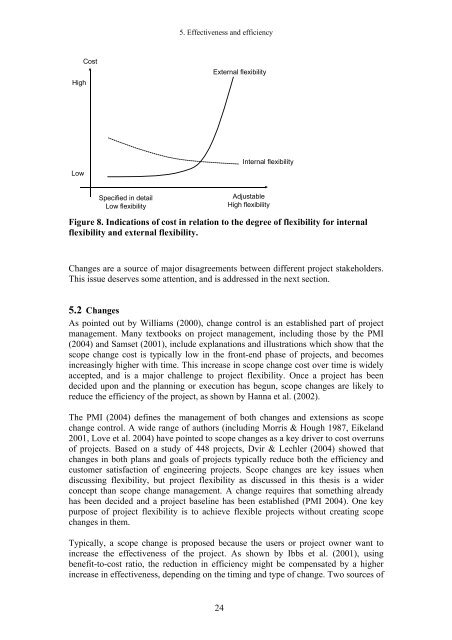Link to thesis - Concept - NTNU
Link to thesis - Concept - NTNU
Link to thesis - Concept - NTNU
Create successful ePaper yourself
Turn your PDF publications into a flip-book with our unique Google optimized e-Paper software.
5. Effectiveness and efficiencyHighCostExternal flexibilityLowInternal flexibilitySpecified in detailLow flexibilityAdjustableHigh flexibilityFigure 8. Indications of cost in relation <strong>to</strong> the degree of flexibility for internalflexibility and external flexibility.Changes are a source of major disagreements between different project stakeholders.This issue deserves some attention, and is addressed in the next section.5.2 ChangesAs pointed out by Williams (2000), change control is an established part of projectmanagement. Many textbooks on project management, including those by the PMI(2004) and Samset (2001), include explanations and illustrations which show that thescope change cost is typically low in the front-end phase of projects, and becomesincreasingly higher with time. This increase in scope change cost over time is widelyaccepted, and is a major challenge <strong>to</strong> project flexibility. Once a project has beendecided upon and the planning or execution has begun, scope changes are likely <strong>to</strong>reduce the efficiency of the project, as shown by Hanna et al. (2002).The PMI (2004) defines the management of both changes and extensions as scopechange control. A wide range of authors (including Morris & Hough 1987, Eikeland2001, Love et al. 2004) have pointed <strong>to</strong> scope changes as a key driver <strong>to</strong> cost overrunsof projects. Based on a study of 448 projects, Dvir & Lechler (2004) showed thatchanges in both plans and goals of projects typically reduce both the efficiency andcus<strong>to</strong>mer satisfaction of engineering projects. Scope changes are key issues whendiscussing flexibility, but project flexibility as discussed in this <strong>thesis</strong> is a widerconcept than scope change management. A change requires that something alreadyhas been decided and a project baseline has been established (PMI 2004). One keypurpose of project flexibility is <strong>to</strong> achieve flexible projects without creating scopechanges in them.Typically, a scope change is proposed because the users or project owner want <strong>to</strong>increase the effectiveness of the project. As shown by Ibbs et al. (2001), usingbenefit-<strong>to</strong>-cost ratio, the reduction in efficiency might be compensated by a higherincrease in effectiveness, depending on the timing and type of change. Two sources of24
















